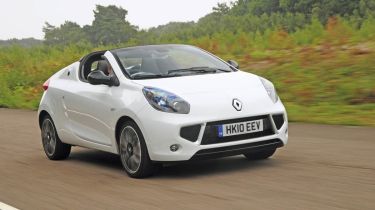Renault Wind
Twingo-based cabrio impresses with unique roof and fun drive
Say what you like about the styling of the new Renault Wind, but its form definitely follows its function. As it shares its underpinnings with the Twingo city car, designers had to work within tight constraints during the development process.
It’s only 3,833mm long (that’s 204mm shorter than the 207 CC), and the stylists had to incorporate the unique flip-folding roof into the package. As a result, the Wind is a bit of a visual mismatch.
Large side buttresses house the mechanism for the powered rotating hard-top, but they give the car a bulky appearance. Slab sides and a short wheelbase mean the Renault isn’t the sleekest car in the class, although its clean nose and some sharp crease lines on the flanks add purpose.
It’s best viewed from the rear, where the neatly incorporated spoiler, sharp tail-light clusters and well proportioned panels give the impression of a proper coupé.
From a distance, the dark roof looks like a fabric design, but it’s made of lightweight composite polyurethane. It folds quickly with as little fuss as a traditional canvas hood. Twist and release the manual catch, and the automated roof pivots round on its axis between the quarter panels. It slots under the raised bootlid in 12 seconds.
Used - available now

2024 BMW
2 Series Gran Coupe
20,431 milesAutomaticPetrol1.5L
Cash £22,099
2022 Volvo
S60
15,501 milesAutomaticPetrol2.0L
Cash £23,599
2021 Mercedes
A-Class Saloon
9,754 milesAutomaticDiesel2.0L
Cash £22,499
2023 Honda
CR-V
14,943 milesAutomaticPetrol2.0L
Cash £27,060This is an ingenious solution, with no folding parts. And unlike in the Peugeot, boot capacity is unaffected when you drop the hood. The healthy 270-litre load bay can swallow a couple of suitcases, and there’s a storage shelf behind the front seats.
Although there’s no reach adjustment on the steering wheel, the driving position isn’t bad. But other aspects of the cabin let the side down.
The rough grade plastics are simply not up to standard, plus the scattered layout of switches isn’t very logical. The driving experience is much better.
The Wind turns into corners positively and grips reassuringly, while the chassis is rigid and suffers less flex than the 207 CC. As a result, the dynamics don’t change once the roof is folded.
The Renault has a firmer brake pedal, too, and at the test track, it recorded better stopping distances than its rival. The biggest black mark is against the steering, which is artificial and doesn’t provide enough feedback.
You also have to work the 1.6-litre engine hard to extract decent performance; it’s lethargic low in the revs and picks up from 5,000rpm. It sounds raspy all the way to the red line, in contrast to the Peugeot’s punchy delivery.
This is highlighted by the Wind’s in-gear performance.
It took 1.5 seconds longer to cover 30-50mph in third gear, posting a time of 5.2 seconds. Plus, it’s not as flexible at higher speeds, as its five-speed manual box has one less ratio than the Peugeot’s.
The Wind doesn’t creak and crash over bumpy roads as much as the 207, although at motorway pace, wind and tyre noise is excessive. The question is whether this will hold the new model back in the final analysis.
Details
Chart position: 1
WHY: Despite using city car underpinnings, the Wind blends distinctive looks with a highly sophisticated roof mechanism, and promises affordable fun







